Bagh Durbar
| Bagh Durbar | |
|---|---|
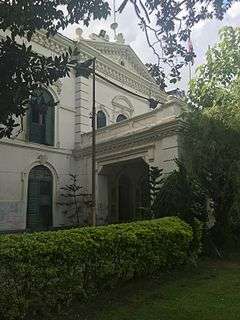 | |
| General information | |
| Architectural style | Neoclassical architecture and Mughal architecture |
| Town or city | Kathmandu |
| Country | Nepal |
| Cost | Unknown |
| Client | Amar Singh Thapa (Sanu), Bhimsen Thapa |
| Technical details | |
| Structural system | Brick and Mortar |
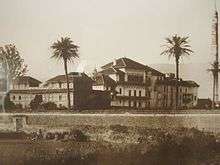
Bag Durbar, Bagh Durbarl is a Rana palace in Kathmandu, the capital of Nepal. The palace complex, located west of the Dharahara and Tundikhel, incorporates an impressive and vast array of courtyards, gardens and buildings. Initially the palace was owned by Amar Singh Thapa (Sanu) [note 1] and his descendent but later was occupied by Royals of Shah dynasty,and later by government of Nepal.[1]
History
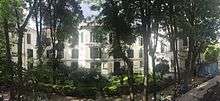
The palace complex lay in the heart of Kathmandu, to the north of the Bagmati River.[2] The history of the palace is closely linked with the history of Nepal and its rulers.
Under Thapa
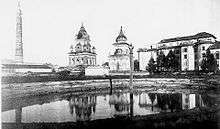
In Royal courtier family Thapa some lived in Thapathali Durbar complex and some lived towards the west of the Sundhara in today's place of Bag Durbar. Initially a palace was built by Amar Singh Thapa (Sanu)[note 2]and later a new palace was built and used by Bhimsen Thapa due to its close proximity with the Royal Hanuman Dhoka Palace in 1805 CE. After the fall of Bhimsen Thapa in 1837, this entire palace complex was seized by Government of Nepal but was later occupied by Prime Minister Mathabarsingh Thapa as a descendent and member of Thapa Clan.[1] Bag Durbar was again sized Government of Nepal in 1845 after the murder of Mathabarsingh Thapa by his own nephew Jung Bahadur Rana.
Royals of Shah Family
After governmentalization of Bag Durbar this property was given to Royal Prince Upendra Bir Bikram Shah in 1854 and was kept under house arrest for Treason.Upon his death in 1896 BS this palace was inherited by his son Bhupetindra Bikram Shah and again to Bhupitendra's son Mohan Bikram. As Mohan Bikram was RamRaj (Zamindar of Ram Nagar estate) he started living in Ramnagar, India so his property was used by his step brother Chandra Bikram Shah.
Under Rana
Both Mohan Bikram and Chandra Bikram were the Son-In-Law of Prime Minister Juddha Shumsher JBR so their property was eventually captured by Juddha and his son Hari Shumsher.[1]
Under Government of Nepal
After the death of the Hari Shumsher as he had many sons Bag Durbar was eventually sold to government of Nepal. Currently the palace is occupied by Kathmandu Metropolitan Office.
Name
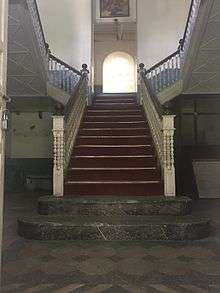
It is believed that Prime Minister Mathabarsingh Thapa kept tigers caged at the entrance of the palace giving this palace its name Bag durbar literally translates as Tiger Palace.[1][3]
Earthquake 2015
This Palace was seriously damaged during the April 2015 Nepal earthquake.Currently the Kathmandu Metropolitan Office has started evacuation. The future of the Historical building is unknown.[4]
See also
References
Footnotes
- ↑ Not to be confused with the better known commander of Gorkhali forces in the Gurkha War with the same name. The two Amar Singhs are differentiated by the qualifier Bada (greater) and Sanu (lesser).
- ↑ Not to be confused with the better known commander of Gorkhali forces in the Gurkha War with the same name. The two Amar Singhs are differentiated by the qualifier Bada (greater) and Sanu (lesser).
Notes
- 1 2 3 4 JBR, PurushottamShamsher (2007). Ranakalin Pramukh Atihasik Darbarharu [Chief Historical Palaces of the Rana Era] (in Nepali). Vidarthi Pustak Bhandar. ISBN 978-9994611027. Retrieved 2015. Check date values in:
|access-date=(help) - ↑ "THE HISTORIC DURBARS OF KATHMANDU". 2014-10-19. Retrieved 2015-06-05.
- ↑ http://www.thetaranights.com/baghdurbar-the-tiger-palace/
- ↑ http://nepalitimes.com/blogs/mycity/2015/05/20/rana-palaces-after-the-earthquake/